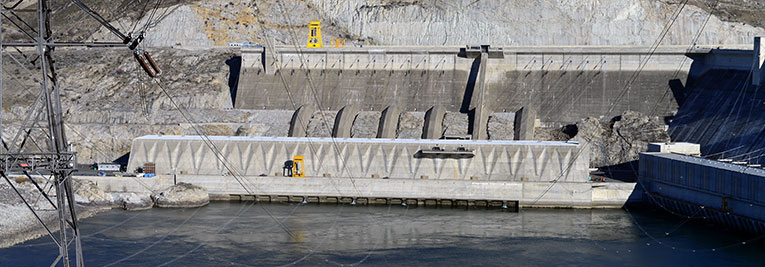Nathaniel "Nat" Washington Power Plant History

The need for more water storage on the Columbia River became evident in the spring of 1948 when the river overflowed its banks due to a heavy snowpack and rain-on-snow events. Not even Grand Coulee Dam could hold back all the flood waters. With the flow of the river measured at 573,000 cfs on May 29, a levee broke in the lower Columbia River and 20,000 homes in Vanport, Oregon were destroyed. Over the next decade, discussions occurred between Canada and the United States concerning additional water storage space.
A compromise between the two nations in 1960 called for the construction of Duncan Lake, High Arrow, and Mica dams in Canada, and Libby Dam in the United States. The agreement further specified that the United States would pay one half the cost allocated to flood control, and Canada would not divert the Columbia River water for at least sixty years.
On January 17, 1961, President Eisenhower signed the Columbia River Treaty. Congress then ratified the treaty, but the Canadian government did not. The provincial government rejected the use of American funds to construct Canadian storage reservoirs and expressed concern over recovery of the Canadian share of the jointly produced power. It took another two years for the sides to agree. In 1964 President Johnson and Prime Minister Pearson signed the new Columbia River Treaty and Protocol on September 16 at the Peace Arch in Blaine, Washington.
The signing of the treaty and construction of storage reservoirs in Canada finally made a third powerplant at Grand Coulee feasible. On June 14, 1966, President Johnson signed a bill authorizing construction of the Third Power Plant in a White House Rose Garden ceremony.
Construction of the Nathaniel “Nat” Washington Power Plant began in 1967 after Interior Secretary Udall announced the new powerhouse would use 600,000 kW generators instead of 300,000 kW ones as originally planned. This change would make Grand Coulee the largest power producer in the world as well as home to the largest generators in the world.
Prior to issuing the specifications for the last three units, engineers realized that by using stator windings that were water cooled it would be possible to increase the capacity even further. Specifications for the last three units required a continuous overload capacity of 805,000 kW. These specifications meant that the units would be breaking new technological ground and Reclamation engineers would have to solve any problems developed along the way.
Not long after the announcement, the Soviet Embassy phoned the U.S. Department of the Interior to inquire if the powerhouse contracts would be open to international bidding. If the Soviets won the bid, they could claim at least a portion of the world’s largest powerplant. The U.S. Department of the Interior ended all discussion on the matter by announcing only domestic bids would be accepted.
Part of the construction of the Nathaniel “Nat” Washington Power Plant included removing a section of the existing dam. The east end of Grand Coulee Dam was blown off and the new power plant structure was attached. The addition of the Nathaniel “Nat” Washington Power Plant lengthened the dam to 5,223 feet, only 57 feet short of a mile.

